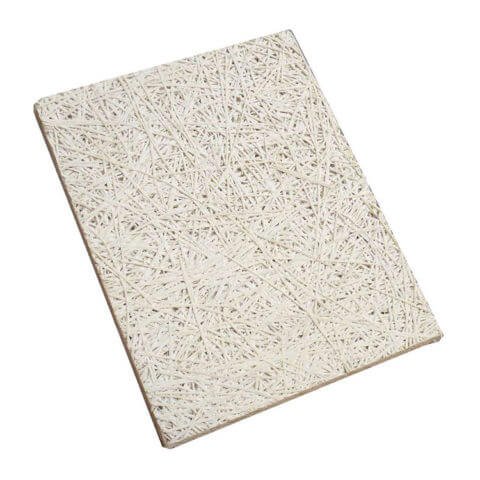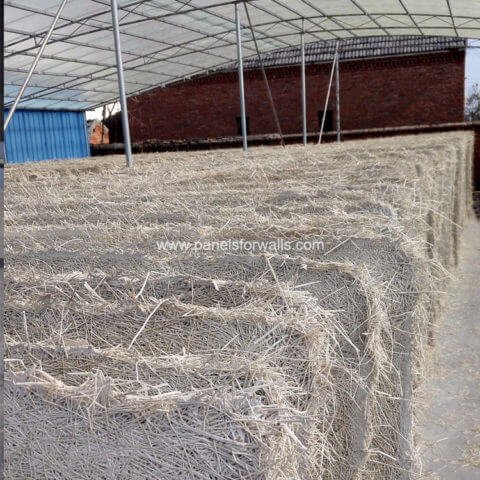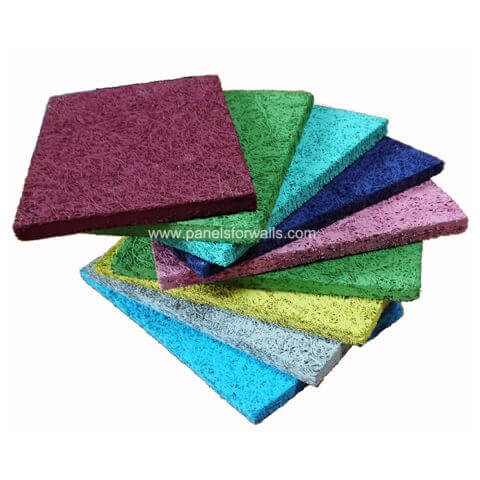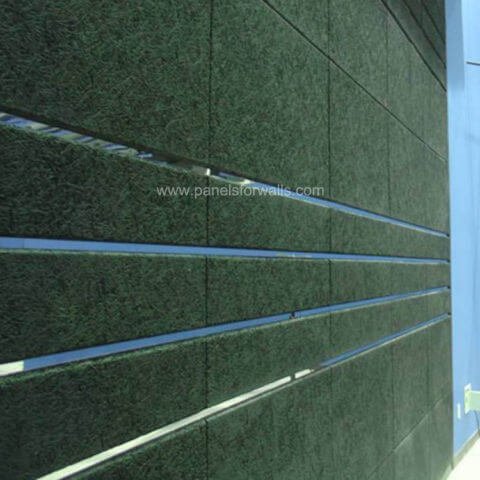I. Introduction
Wood wool acoustic panels have become an increasingly popular soundproofing material in recent years, making for an enjoyable acoustical environment. Here, we explore their pros and cons compared with other soundproofing materials to help make an informed decision for your soundproofing needs.

II. Overview of Wood Wool Acoustic Panels
Woodwool acoustic panels (commonly referred to as woodwool or wood wool panels) are sound-absorbing panels created from wood fibers. Compressed into rigid boards for use as sound absorption material, these durable and environmentally friendly boards offer outstanding sound absorption properties while remaining eco-friendly.
Unique Properties and Benefits
Wood wool acoustic panels stand out as one of the greatest advantages to using them as noise absorbers, thanks to the combination of wood fibers and cement creating a porous structure that effectively absorbs sound waves reducing echo and reverberation in any given space. They make ideal solutions for recording studios, auditoriums, offices and restaurants where noise control is vitally important.
Woodwool panels not only offer excellent acoustic performance, but also aesthetic value. Their natural textures and warm wood fibers add warmth and elegance to any space; or these interior wood panel walls can be painted various colors to match the desired interior design style.

Applications in Residential and Commercial Settings
Wood wool acoustic panels find applications both residentially and commercially. At home, these panels can create an immersive home theater or bedroom experience; while in commercial settings like conference rooms and restaurants they improve speech intelligibility while increasing overall acoustic comfort for guests.
How to put wood panelling on walls? Wood wool panels are an extremely flexible solution, as they can be installed both walls and ceilings with ease. Their rigid structure enables easy mounting, and they can even be tailored to meet specific dimensions or design specifications. Thanks to their ability to absorb sound while adding visual interest, these acoustic panels have quickly become a favorite choice among architects, interior designers, and homeowners.

III. Comparison with Other Soundproofing Materials
When exploring soundproofing options, it’s essential to evaluate alternatives to acoustic woodwool panel. Let’s compare them against three popular materials such as fiberglass insulation, foam panels and mineral wool.
Fiberglass Insulation
Fiberglass insulation is an increasingly popular material used in buildings for thermal and acoustic insulation purposes, composed of fine glass fibers spun together to form dense mats. Although fiberglass offers some soundproofing capabilities, how does it compare to wood wool acoustic panels?
Pros of Fiberglass Insulation: It can effectively reduce airborne sound transmission. – Widely available and relatively affordable. It also can improve thermal insulation as an added benefit.
Cons of Fiberglass Insulation: Installation can be messy and require protective gear due to the microscopic glass fibers present. Longevity may become an issue over time due to compression or degeneration, and its environmental friendliness cannot compare to wood wool panels due to glass fiber use.

Foam Panels
Foam panels made of materials like polyurethane or polyethylene are another popular choice for soundproofing. Their cellular structure helps absorb sound waves. Let’s compare how these hold up against wood wool acoustic panels.
Pros of Foam Panels: Inexpensive and simple to install. Its Some foam panels provide fire protection features as an added advantage.
Cons of Foam Panels: They may not be as effective at absorbing low-frequency sounds than alternative materials. Some foam materials can degrade over time, leading to reduced performance. Maintenance can be challenging since foam panels may accumulate dust quickly and need frequent cleaning.
Mineral Wool
Mineral wool (also referred to as rock wool or stone wool) is an insulation material composed of volcanic rock or slag that offers both thermal and acoustic insulation properties. We’ll compare its performance against wood wool acoustic panels below.
Pros of Mineral Wool: Mineral Wool offers excellent thermal and fire insulation properties. In some applications, its fire resistance makes it safer than alternatives like fiberglass insulation.
Cons of Mineral Wool: Although mineral wool panels can be more costly than their wood wool counterparts, professional installation assistance may be required due to its denser and heavier nature. Furthermore, its production process involves higher energy usage which should be considered when considering environmental impact assessment.
Continue to follow this blog post as we delve deeper into the advantages and disadvantages of wood wool acoustic panels as opposed to other soundproofing materials, taking into account insulation properties, costs and environmental considerations so that you can make an informed decision for your soundproofing needs.

IV. Wood Wool Acoustic Panels Have Special Advantages
Decorative wood wool panels possess several unique properties that set them apart from other soundproofing materials, and contribute to their increasing popularity across various applications. Let’s examine some of these special attributes of these boards:
Natural and Sustainable Properties
Timberwool wood fiber panels boast natural and sustainable qualities that make them an eco-friendly option. Most of their production comes from sustainable forests that utilize renewable materials responsibly – this feature makes wood wool panels attractive choices for projects seeking eco-conscious materials.
Regulation of Humidity
Wood wool acoustic panels have the unique capability of controlling humidity levels within any given space, thanks to their porous structure which absorbs and releases moisture to help create an ideal indoor climate. This feature can prove especially helpful in areas with fluctuating humidity levels.
Enhanced Indoor Air Quality
Wood wall panel system contributes to improved indoor air quality by using natural wood fibers that do not release volatile organic compounds (VOCs), making it healthier option for interior spaces and helping create a cleaner and more breathable atmosphere.
Thermal Insulation
Wood wool acoustic panels provide thermal insulation benefits in addition to sound-absorbency. Their combination of wood fibers and cement creates a material with inherent insulation properties which helps regulate temperatures while decreasing energy consumption, leading to greater energy efficiency within a building.

V. Cost Considerations
When researching soundproofing options, cost is always an important consideration. Wood wool acoustic panels’ pricing can vary based on multiple factors; let’s discuss this cost element of wood wool panels before providing general comparisons between them and other soundproofing materials.
Factors Influencing Cost: The cost of acoustic panel wood wool depends on a number of variables, including panel size, thickness, design complexity and customization options. Furthermore, brand, quality and supplier can have an effect on pricing as well. Therefore, it is advisable to request quotes from various manufacturers or suppliers in order to get an accurate estimation based on your specific requirements.
Wood Wool Panels Prices: Wood wool panel prices can differ depending on your region and market conditions, with prices often being slightly higher than conventional soundproofing materials such as fiberglass insulation or foam panels; however, it’s essential to take into account their unique properties as well as aesthetic appeal when making this decision.
As with any purchase decision, soundproofing materials should be assessed against their performance, durability and project requirements before considering cost considerations. An informed decision requires taking into account potential long-term benefits like cost-savings through high quality soundproofing materials such as wood wool acoustic panels.
Stay tuned for next part of this blog post where we will continue our examination of wood wool acoustic panels as an alternative soundproofing material, including their installation requirements, durability, how to put up wood paneling on walls, and how to clean wood paneling walls.

Mineral Bonded Wood Wool Board | Acoustic Wood Wool Board Installation
Wood Wool Board Price | Wood Wool Insulation Board Manufacturers Wood Wool Material In Theater Wood Wool Price

Woodwool Board Manufacturer | Wood Wool Boards
Woodwool Slabs Fire Resistance | Woodwool Panels Sound Absorption Woodwool Acoustic Ceilings Acoustic Woodwool Panel
VI. Manufacturers and Suppliers
When purchasing wood wool acoustic panels for soundproofing purposes, it is imperative that they come from reliable wood wool acoustic panel manufacturers and suppliers. Below are a few noteworthy companies in this space:
- Baux: It is an internationally-recognized manufacturer of baux acoustic wood wool panels, known for their exquisite craftsmanship, innovative designs and eco-friendly manufacturing practices. The panels come in various shapes, sizes and colors to meet a variety of design requirements.
- PanelsforWalls: PanelsforWalls is an industry leader when it comes to wood fiber panels, including wood wool acoustic panels. Providing customizable options tailored specifically to meet project requirements with quality and environmental sustainability in mind, their durable yet eco-friendly wood wool panel solutions have garnered them significant praise from customers worldwide.
When purchasing wood wool acoustic panels, it is imperative to select acoustic wool wood panel suppliers with impeccable credentials and ensure you find reliable sources. Here are a few ways you can do just that:
- Research and Reviews: Conduct in-depth research to identify reputable suppliers, looking for customer reviews to gauge the quality of their products and services.
- Certifications and Standards: Ensure your supplier abides by industry standards and certifications for manufacturing and environmental practices to ensure high-quality, eco-friendly wood wool acoustic panels are provided to you.
- Samples and Specifications: When considering suppliers, request samples or detailed specifications so you can assess their products’ quality, acoustic performance, and suitability for your project. This allows you to assess product’s quality as well as suitability for use.
- Customer Support: Evaluate the level of customer support offered by each supplier. Prompt responses, clear communication and an eagerness to address queries or concerns indicate a reliable provider.

Wood Wool Acoustic Panel China | Wood Fiber Panel
Wood Wool Acoustic Panel Manufacturers Customized Panel Wholesale | Wood Wool Acoustic Panel Made in China Wood Wool Cement Board China

Wood Wool Partition Wall Manufacturer | Wood Wool Board Installation
Woodwool Panel | Wood Wool Partition Wall Price Factory Wood Wool Partition Wood Wool Wall
VII. Conclusion
Wood wool acoustic panels provide numerous advantages over other soundproofing materials, and we have explored both their advantages and disadvantages when compared with alternative solutions in this blog post. Here is a quick recap of key points discussed:
Acoustic wood wool panel excels at absorbing sound waves, reducing echos, and overall improving acoustical quality in any given space.
- Aesthetics: Wood wool panel offers an aesthetically pleasing texture such as hexagon wood tile that adds warmth and charm to any interior design scheme.
- Durability:Wood wool panels are well-known for their long-term performance, making them a safe and cost-effective way of soundproofing applications.
- Eco-Friendliness: Wood wool acoustic panels are often constructed using eco-friendly materials, making them an environmentally conscious option.
- Variety: These panels can be utilized in multiple settings, such as offices, educational institutions, auditoriums and residential properties.
Wood wool acoustic panels provide numerous advantages that make them an excellent solution for soundproofing needs, whether your priority lies with aesthetics, performance or sustainability. Wood wool panels offer an all-inclusive solution tailored to each of these aspects and more!










